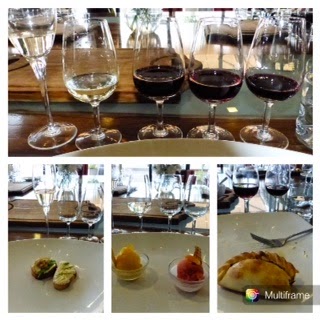Kitty is our guide today :)
Wine Tasting Terms
Acidity
- Acidity is a term that refers to the amount of acid in a wine. Acid
is the chemical compound that makes things taste tart, like vinegar or
citrus foods. Acidity is part of the structure of wine, giving it lift
and intensity. Without acidity wines taste flat or flabby while with too
much acidity they can be seem shrill, tart and excessively lean.Aroma
- The aroma, also known as the "nose" of a wine, is what the wine
smells like. It includes all the various smells you get when sniffing
the wine.
Backward - This is a wine tasting term used to
describe a wine which is young and not showing well. It is backward
because the structure (acid and tannin) are in the forefront while
everything else (fruit flavors, etc.) are hiding behind the structure.
Sometimes a backward wine will open up with additional aeration in a
decanter, but it often means the wine is young and needs more time.
Balance
- The best wines have perfect balance, meaning that all the components
of the wine (the structure, fruit, alcohol, secondary flavors, etc.) are
all in equilibrium, none sticking out in the forefront too much. When
all the parts harmonize like this, the wine has a sense of elegance and
completeness which is the hallmark of a great wine.
Barnyard
- You will often hear people describe a wine as having barnyard aromas
or related terms like "horsey, manure, animal, etc." This literally
means there are aromas that smell a bit stinky. However, this isn't
always a bad thing! You'd be surprised but many people like a little
stink in their wines, adding to the complexity. Too much may be
off-putting, but a bit can be nice. This is sometimes just a product of
the wine and where it came from, but in some cases can be related to a
bacteria called Brettanomyces, or Brett for short, which can have these
characteristics. Don't worry, it is harmless! Some people like a bit of
Brett in wine and others don't.
Berry - Berry aromas and
flavors are very common in wine. When someone describes a wine as
smelling like berries, it doesn't mean that there were berries used to
make the wine. All traditional wines are just made from grapes. But
those grapes, depending on the type and where they were grown, can
develop complex aromas, often imitating various other fruits. Common
berries and related fruits to find in wine include cherries,
strawberries, blueberries, cranberries, raspberries, blackberries and
currants. You can use any of these and more as wine tasting terms or
descriptors.
Body - The body of a wine is the size or heft
of it in your mouth. While a light bodied wine glides over your palate
softly and without weight, a full-bodied wine feels heavy and big in
your mouth.
Bouquet - The bouquet is another term for the
aroma of a wine. It is usually used to describe the smell of a wine
which is complex, offering many different types of aromas.
Creamy
- This is a descriptor of the feel of the wine in your mouth, the
mouthfeel. A creamy wine literally feels creamy in your mouth, having a
richness similar to heavy cream. This is common in rich wines with low
acid such as is common with California Chardonnays. It is usually a
result of both malolactic fermentation and oak aging which adds a
rounded texture to wine.
Chewy - Another wine tasting term
describing the mouthfeel of the wine. A chewy wine is big and burly,
feeling almost like a solid in your mouth rather than an ethereal light
liquid. This is a common descriptor for full-bodied wines that are a bit
rustic like some Syrahs, Chateauneuf-du-Pape and others.
Closed
- Another one of the wine tasting terms that is often used to describe a
wine which is too young or going through a phase that it is not showing
that much. Similar to backward, a closed wine may hint at greatness but
isn't giving up the goods. Many wines that require aging go through
closed phase where you don't get much aroma or flavor out of it only to
later blossom and show its depth and complexity. Again, aerating a
closed or backward wine may help bring out some of its personality, but
in some cases this won't work.
Complex - This describes a
wine which has a myriad of aromas and flavors. The opposite of a
"simple" wine, a complex wine has various aromas and flavors that
compliment each other.
Corked - This is one of the
confusing wine tasting terms for beginners. It does not mean that the
cork has been pulled out. It also does not mean that the wine smells
like cork (good cork doesn't really smell like anything). What it means
is that the wine is flawed because it has been exposed to a compound
called TCA (2,4,6-traichloroanisole). TCA generally comes from mold
which has infected the cork. This compound has a distinctive musty aroma
that some people describe as moldy, wet newspaper or cardboard, wet dog
or a damp basement. Even a small amount of this can obscure the normal
aromas and flavors of a wine and thus this is a faulty wine. Some people
are more sensitive to TCA then others.
Dry - Another of
the more confusing wine tasting terms, dry can be used a couple
different ways. Most accurately, dry describes a wine which has no
residual sugar, the opposite of sweet. However, most newbies use dry to
describe the mouthfeel of a tannic wine. Tannins have a mouth drying
feeling. When many people say that a wine is very dry, they mean it has
lots of tannin, they are not commenting on the level of sugar in the
wine. So try to avoid using dry to describe tannins, be as specific as
possible so that people know what you mean. Just as an example of how
this can be confusing, young Vintage Port, a dessert wine from Portugal,
is very sweet with residual sugar, but at the same time has large
amounts of tannin. Therefore, someone could potentially say these are
sweet AND dry! Quite confusing indeed!
Earthy - Grape wines
grow in dirt (and stones and rocks, etc.). Therefore, it is not
surprising that some wines have aromas or flavors resembling earth and
are described as earthy. This is not a bad thing. This can often be a
very nice complexity that compliments the fruit aromas and flavors in a
wine.
Finish - The finish is the aftertaste of a wine. A
great wine has a long finish which lingers pleasingly on your palate. It
should be long and have good flavors and sensations in your mouth,
tempting you to take another sip. A bad finish is one which is very
short or has off flavors (bitter, astringent, etc.) which are not
appealing.
Flabby - A wine without enough structure,
particularly acid and tannin, to stand up to its other components can be
described as flabby. It feels flat and without intensity and can even
seem syrupy.
Floral - One of the wine tasting terms
describing a wine with flower-like aromas or flavors. This can be a very
pretty complexity in some wines.
Herbal - A wine that has aromas or flavors of herbs. Again, this can be a nice complexity as long as it is not overpowering.
Intense
- This describes a wine which packs a punch flavor-wise. An intense
wine explodes in your mouth with flavor, making a big impact on your
palate. This doesn't mean that wine is necessarily full-bodied or heavy.
Instead it means that it has powerful flavors and often has acidity
that helps make those flavors stick out powerfully. So you can have a
light-bodied wine, like a German Kabinett Riesling, which has intense
flavors.
Jammy - One of the wine tasting terms that
describes a very ripe wine, often fairly low in acid, so that its fruit
flavors and feel resemble jam.
Musty - A damp, moldy aroma, often associated with TCA (a corked wine) but can also be present in some wines which are not corked.
Oaky
- One of the most widely used wine tasting terms, oaky describes a wine
with noticeable oak aromas and flavors. While subtle oakiness that
integrates well with the other aromas and flavors in wine is often
desireable, excessive oakiness can be a flaw. Different people have
different tolerance for oak, some loving heavily oaked wines and some
prefering little or no oak influence. Generally, oak imparts a woody
aroma and flavor but can also add others as well. Depending on how
charred the oak barrels were, you can get mild contributions of vanilla
and toast all the way up to heavily charred and roasted coffee,
chocolate and even burnt toast.
Oxidized - Most wines
should not be oxidized, which is caused by excessive exposure to oxygen.
Sherry, most notably, is made in a way that encourages oxidation, and
thus oxidized wines are also described as "Sherried" as well. If you
don't know what Sherry smells like, it tends to have a nutty aroma.
Oxidized wine can also generally be somewhat flat tasting and darkens in
color, turning brown.
Silky - This describes the
mouthfeel of the wine as being silky in texture. Silky is considered to
be the most soft and caressing of wine textures, often reserved to
describe light- to medium-bodied wines with a soft grained texture like
silk. Great wines have great mouthfeel, feeling complete and balanced
but also having a texture that is very pleasing to your palate.
Simple
- This is the opposite of complex, meaning that a wine has
straightforward, one-dimentional aromas and flavors. It lacks depth and
complexity.
Smoky - Wines can have smoky aromas either from
their own characteristics (for example, Cote-Rotie typically has a
smoky bacon-like aroma) or from oak aging. Oak, particularly if it is
heavily charred, can impart a profound smoky, roasted aroma.
Spicy
- While spicy generally describes something which is hot, like hot
peppers or salsa, in food, spicy, in wine tasting terms, describes a
wine with aromas or flavors of spices such as cinnamon, clove, pepper,
or nutmeg.
Structure - The structure of a wine is those
components which tend to support the body of the wine, holding it
together, giving it lift and intensity. Acid, tannin and alcohol can all
be said to be parts of a wine's structure. A very structured wine is
one in which one or more components of the structure are quite
predominant. While a wine needs structure to be balanced and avoid
feeling flabby and flat, too much structure can feel harsh if out of
balance with the other components of the wine. In general, wines that
age well have considerable structure when young.
Sweet -
Another wine tasting term that is often misunderstood or misused because
of its various uses. Sweet can mean that there is residual sugar in the
wine which gives a sweet flavor like sugar. This is true mostly of
dessert wines like Port, Sauternes, sweet Muscat, and others. Most table
wines do not have significant residual sugar, with the exception of
some Pradikat level German wines like Kabinett, Spaetlesen and Auslesen.
Most "table wines" have no residual sugar and therefore are not sweet by
that definition. However, sweet is also used to describe a
characteristic of the fruit in a wine. If a wine has ripe, fruity
flavors, it can often be described as sweet. In this context it does not
mean that it is literally sweet with sugar in it, but rather that it
simply gives the impression of sweetness due to the ripe fruit flavors.
This can be true of many table wines, white and red.
Tannic
- Describing a wine with a lot of tannin, the compound found in grape
skins and stems. This creates the drying, slightly astringent sensation
in your mouth. Red wines generally have much more tannin than white
wines. Full-bodied red wines are often described as tannic in their
youth. Tannins can be ripe and fairly soft and velvety in texture, or if
they are green, they can be quite harsh and astringent. Tannins tend to
fade away slowly with age.
Vegetal - Describes a wine with
significant vegetable-like aromas or flavors. While a bit of this is
often nice, too much can be off-putting and considered a flaw, often
resulting from under-ripe grapes.
Velvety - Another wine
tasting term describing the texture or mouthfeel of a wine. A velvety
wine is one that is caressing and smooth like velvet. This is usually
used to describe a wine that is slightly less soft and fine-grained than
a "silky" wine, often for slightly fuller-bodied wines. The best wines
will have a great mouthfeel, being either silky or velvety in texture.
Our next featured couple will be
Jeannine and Soulivanh Vongkeo
....stay tuned!!! |



































 ... Interesting what is mentioned under Argentina... soon we will know if this is true...
... Interesting what is mentioned under Argentina... soon we will know if this is true... 












